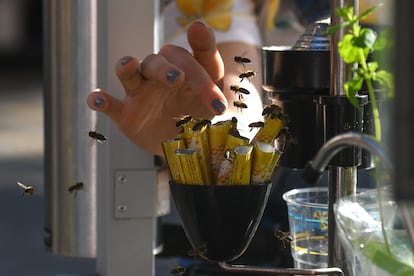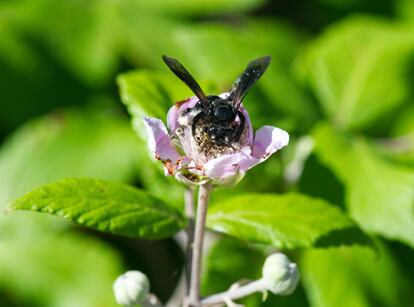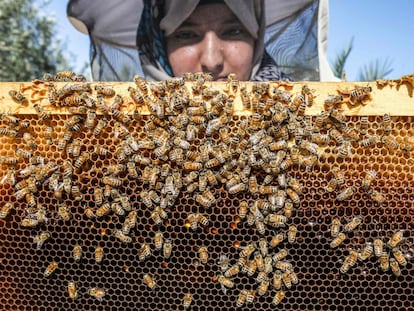The bees with the biggest heads prefer the city
A study of almost 100 species of these insects confirms that brain size is related to a greater capacity to adapt to new environments

Nowadays, the violet carpenter bee (Xylocopa violacea) is easier to find in cities than in its original environment. Although it is a bee, it is so big and black that many people consider it a bumblebee. That size seems to have helped it colonize a world that is very different from its own, full of new opportunities, but also dangers: the city. Now, a new study with dozens of species of bees and bumblebees shows that those with larger heads have a greater presence in urban areas, a finding that would confirm among insects something already observed in other living beings, including humans: that a larger brain improves the adaptation capabilities.
With only 10,000 years of history, cities are something new for the species that have lived on the planet for thousands, even millions of years. Some were able to adapt right away, such as domestic animals, rats or cockroaches, but in general, these are ambiguous environments for animal life. They can be dangerous, particularly for the predators that competed with humans. However, this has not prevented many living beings from taking advantage of the benefits that they also offer, such as the absence of enemies and competitors, availability of food and better climatic conditions. For some birds and mammals, cities have become a last refuge. But why have some beings adapted to the cities and others not? The size of their heads might be the answer.
A group of Spanish scientists asked themselves the same question, focusing on the family of species to which bees and bumblebees belong, the Apidae. They studied the presence of 89 species from North America and Europe in three environments: natural, agricultural and urban. At the same time, they measured their average sizes, that of their heads and their body-head proportion. The results of their work, published in the scientific journal Biology Letters, show that, in general, bees do not like the city. Specifically, finding specimens of 56 species in urban parks and gardens was rare or exceptional, always below 20% of observations of the species. However, there are 28 others that do frequent the cities; some of them, such as the aforementioned violet carpenter bee or the European wool carder bee (Anthidium manicatum), already feed more on urban flowers and pollen than on rural or natural pollen. Of the latter, for instance, they registered 2,800 urban observations, compared to 350 in natural systems. “The fact that they do well in urban areas doesn’t mean that they can’t be found in natural environments,” points out José B. Lanuza, first author of this research when he worked at the Doñana Biological Station, in Spain.
“The presence or absence of bees in urban environments is not fortuitous. We see a correlation: species with larger heads tend to concentrate a greater number of specimens in cities,” explains Lanuza, now at the German Center for Integrative Biodiversity Research (iDiv) Halle-Jena-Leipzig. There may be other factors that explain it, such as diet, but they saw that among the urban specimens there were both generalist or polylectic bees (that feed on pollen and nectar from several kinds of flowers) and specialists that only drink from one family of flowers. Furthermore, the relationship between head size and urbanity becomes more consistent as the proportion between head and body increases. It is logical and expected that large species such as the violet carpenter bee do well in cities: their large size makes it easy to move from one park to another, traveling distances that smaller bees might not be able to cover. However, there are species, such as the A. manicatum or the hairy-footed flower bee (Anthophora plumipes), which have a relatively larger head, and they are among the most urban there are. The opposite was also observed: species with smaller heads, or lower head-to-body ratios, tend to be seen less in the city.

In 1993, evolutionary biologists proposed the idea of the cognitive buffer. This hypothesis suggests that greater cognition protects animals against environmental changes by aiding their decisions regarding where to live, what to eat or what risks to avoid. If we accept that brain size is related to cognitive abilities, it can be concluded that species with larger heads will have greater plasticity, something that would fit in environments as changing as the city. This connection has been observed in birds and mammals, particularly primates. “Especially in humans,” says Daniel Sol, researcher at the Center for Ecological Research and Forest Applications of the Autonomous University of Barcelona.
“This cognitive protector helps us decide what to do when we are exposed to changes and new environments. It gives us the ability to choose,” he explains. “Humans are the best example of the cognitive buffer, with which we have conquered the planet,” adds Sol, who has studied it in different groups of animals, such as birds. “Some species don’t have to modify their behavior. Pigeons and doves still eat in the city what they used to eat in the countryside. But others, such as herons or corvids, have changed their diet,” he explains. “The cognitive buffer hypothesis had been demonstrated in animals that we consider intelligent, such as crows, parrots or primates,” adds the researcher. They are species with relatively large brains, with an accumulation of neurons in the cerebral cortex, in mammals, or in the pallium, in birds. “But the brains of insects are very small. It was thought that they could not modify complex behaviors, but a series of experiments disproved this.”
“Humans are the best example of the cognitive buffer, with which we have conquered the planet.”Daniel Sol, researcher at the Center for Ecological Research and Forest Applications of the Autonomous University of Barcelona.
In one of these experiments, some bumblebees demonstrated that they were capable of learning from others. In a study with bees that were prevented from sleeping, they showed a worse retention capacity. In 2021, an experiment led by Ignasi Bartomeus, an ecologist from the Doñana Biological Station, found that bees have the ability to learn in new environments. “It was a very simple test in which they had to memorize where the sugary reward was,” says the scientist. They saw that the species with larger heads were more successful. This experiment led them to wonder how bees fared in cities, and they discovered that the species with the larger heads fit in better. Still, Bartomeus warns about not going beyond the results they have already obtained.
The authors acknowledge that the study has its limitations. The first is twofold: it is assumed that a larger head always means a larger brain, and that a larger brain means a greater cognitive ability. “But intelligence is something very complex that we cannot reduce to size,” Bartomeus points out. In addition, the study is based on 89 species, but there are approximately 20,000. Another limitation is that the correlation they observed (bigger head equals greater urbanity) could also go in the opposite direction: that the challenges and opportunities presented by the city have exerted selective pressure, favoring the largest headed insects.
Sign up for our weekly newsletter to get more English-language news coverage from EL PAÍS USA Edition
Tu suscripción se está usando en otro dispositivo
¿Quieres añadir otro usuario a tu suscripción?
Si continúas leyendo en este dispositivo, no se podrá leer en el otro.
FlechaTu suscripción se está usando en otro dispositivo y solo puedes acceder a EL PAÍS desde un dispositivo a la vez.
Si quieres compartir tu cuenta, cambia tu suscripción a la modalidad Premium, así podrás añadir otro usuario. Cada uno accederá con su propia cuenta de email, lo que os permitirá personalizar vuestra experiencia en EL PAÍS.
¿Tienes una suscripción de empresa? Accede aquí para contratar más cuentas.
En el caso de no saber quién está usando tu cuenta, te recomendamos cambiar tu contraseña aquí.
Si decides continuar compartiendo tu cuenta, este mensaje se mostrará en tu dispositivo y en el de la otra persona que está usando tu cuenta de forma indefinida, afectando a tu experiencia de lectura. Puedes consultar aquí los términos y condiciones de la suscripción digital.
More information
Últimas noticias
From Andorra to Gibraltar, a black market for Ozempic exploits its success: ‘They’re the most sought-after products in the world’
Magnets in their heads: How some animals guide themselves using the Earth’s magnetic field
From Hungary’s Orbán to Chile’s Kast: How Trump helps turbo charge the far right
The brief rise and retreat of Generation Z in Mexico
Most viewed
- Why we lost the habit of sleeping in two segments and how that changed our sense of time
- Trump’s obsession with putting his name on everything is unprecedented in the United States
- Charles Dubouloz, mountaineering star, retires at 36 with a farewell tour inspired by Walter Bonatti
- Venezuela faces its most tense Christmas yet
- The Florida Keys tourist paradise is besieged by immigration agents: ‘We’ve never seen anything like this’











































